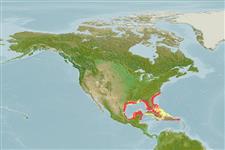Environment: milieu / climate zone / depth range / distribution range
Écologie
marin récifal; non migrateur; profondeur 2 - 92 m (Ref. 9710), usually 5 - 25 m (Ref. 9761). Subtropical; 35°N - 18°N, 100°W - 64°W (Ref. 55264)
Western Atlantic: Bermuda, Bahamas and off southern Florida, USA to the Gulf of Mexico, including Yucatan, Mexico (Ref. 26938).
Taille / Poids / Âge
Maturity: Lm ? range ? - ? cm
Max length : 45.0 cm TL mâle / non sexé; (Ref. 4858); common length : 35.0 cm TL mâle / non sexé; (Ref. 3797)
Soft parts of dorsal and anal fins and caudal fins have wide yellow margins. Dark spot on forehead lacks electric blue ring. Juveniles blue, banded, with last prominent band straight (Ref. 26938). The pectorals are blue basally, clear distally, with a broad yellow band separating the two colors; the pelvic fins are light yellow (Ref. 13442).
Inhabits rocky or coral reefs (Ref. 9710). Juveniles in channels and on inshore reefs (Ref. 9710). Feeds primarily on sponges (Ref. 9710). Small juveniles do well in aquariums once they begin to accept food.
Life cycle and mating behavior
Maturité | Reproduction | Frai | Œufs | Fécondité | Larves
Allen, G.R., 1985. Butterfly and angelfishes of the world. Vol. 2. 3rd edit. in English. Mergus Publishers, Melle, Germany. (Ref. 4858)
Statut dans la liste rouge de l'IUCN (Ref. 130435: Version 2024-1)
Menace pour l'homme
Reports of ciguatera poisoning (Ref. 30303)
Utilisations par l'homme
Pêcheries: intérêt commercial mineur; Aquarium: Commercial
Outils
Articles particuliers
Télécharger en XML
Sources Internet
Estimates based on models
Preferred temperature (Ref.
123201): 23.4 - 27.4, mean 24.6 °C (based on 208 cells).
Phylogenetic diversity index (Ref.
82804): PD
50 = 0.5078 [Uniqueness, from 0.5 = low to 2.0 = high].
Bayesian length-weight: a=0.03162 (0.01607 - 0.06223), b=2.88 (2.71 - 3.05), in cm total length, based on LWR estimates for this species & (Sub)family-body (Ref.
93245).
Niveau trophique (Ref.
69278): 3.0 ±0.0 se; based on diet studies.
Résilience (Ref.
120179): Faible, temps minimum de doublement de population : 4,5 à 14 années (Preliminary K or Fecundity.).
Fishing Vulnerability (Ref.
59153): Low to moderate vulnerability (35 of 100).
Nutrients (Ref.
124155): Calcium = 23.2 [10.6, 42.9] mg/100g; Iron = 0.487 [0.280, 0.845] mg/100g; Protein = 19 [18, 20] %; Omega3 = 0.151 [0.087, 0.259] g/100g; Selenium = 18.6 [8.8, 40.2] μg/100g; VitaminA = 35.5 [8.6, 142.2] μg/100g; Zinc = 0.782 [0.509, 1.170] mg/100g (wet weight);
